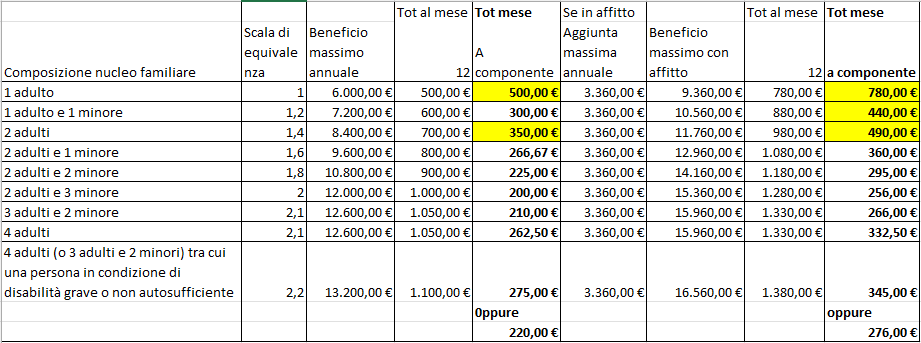How much do the earners of the citizenship income really collect?

Does the citizen's income really contribute to the misalignment between supply and demand of work? Luigi Oliveri's analysis from his blog
The rumor continues to be widespread according to which the Citizenship Income (RdC) contributes to the misalignment between demand and supply of work, because it is too high.
The newspapers continue to read that people are discouraged to find work, because the income allows them to receive 500 or 700 euros per month, so that some jobs, even part-time or not very high wages, would be uncompetitive with an "income" received without having to take up a job.
Just log into the portal to discover that things are not exactly like this. By reworking the tables for the calculation of the MAXIMUM due to family units, we note the following:

In the first place, it must be remembered that the RdC belongs to the family nucleus and not to its single component, which, on the other hand, creates the distortion for which the smallest nuclei are favored and the nuclei with only one component greatly favored.
Secondly, the famous 500 euros per person can only and exclusively go to remote cases in which the beneficiary is just a member and his subjective conditions, Isee in particular, allow to obtain the maximum possible annual amount, that is 6,000.00 EUR.
The figure of 780 euros per month, which is the maximum possible per person, can be reached in the hypothesis – always remote – that that single component has the requisites for the maximum annual amount and is also rented.
In almost all other cases, dividing the income of the nucleus by the individual components, it is easy to notice that the hypothetical individual figure is significantly lower than the famous 500 (or 700) euros per month.
Only where there is an integration for the rent can we see checks which, broken down by component, are close to 500 euros. But, remember once again, this table concerns the maximum ceilings, which are by no means the rule. Most earners receive much smaller checks.
On the other hand, dividing the approximately 7.2 billion that finance the RdC by the approximately 3.5 million people who receive it, the average average gives about 2,057 euros per year per unit, i.e. an average of not even 172 euros per month. .
Moreover, it very often escapes that these resources are not freely expendable, so that it is not entirely correct to consider these figures as a full financial availability.
Looking at reality a little more objectively on the basis of the data, it cannot be overlooked that the RdC, certainly a measure conditioned by many problems and vices, does not guarantee the individual member of a family any freely spendable income remotely comparable to income than a concrete job, full time or with a not too short part time, you can insure.
The RdC certainly does not help the functionality of the labor market, however it cannot be considered the only cause that triggers the problems of matching supply and demand.
This is a machine translation from Italian language of a post published on Start Magazine at the URL https://www.startmag.it/economia/reddito-di-cittadinanza-lavoro/ on Sun, 12 Jun 2022 06:04:21 +0000.
